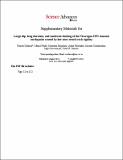Por favor, use este identificador para citar o enlazar a este item:
http://hdl.handle.net/10261/248318COMPARTIR / EXPORTAR:
 SHARE SHARE
 CORE
BASE CORE
BASE
|
|
| Visualizar otros formatos: MARC | Dublin Core | RDF | ORE | MODS | METS | DIDL | DATACITE | |

| Campo DC | Valor | Lengua/Idioma |
|---|---|---|
| dc.contributor.author | Sallarès, Valentí | es_ES |
| dc.contributor.author | Prada, Manel | es_ES |
| dc.contributor.author | Riquelme, Sebastián | es_ES |
| dc.contributor.author | Meléndez, Adrià | es_ES |
| dc.contributor.author | Calahorrano, Alcinoe | es_ES |
| dc.contributor.author | Grevemeyer, Ingo | es_ES |
| dc.contributor.author | Ranero, César R. | es_ES |
| dc.date.accessioned | 2021-08-18T11:28:46Z | - |
| dc.date.available | 2021-08-18T11:28:46Z | - |
| dc.date.issued | 2021-08 | - |
| dc.identifier.citation | Science advances 7(32): eabg8659 (2021) | es_ES |
| dc.identifier.other | CEX2019-000928-S | - |
| dc.identifier.uri | http://hdl.handle.net/10261/248318 | - |
| dc.description | 11 pages, 6 figures, supplementary materials https://advances.sciencemag.org/content/suppl/2021/08/02/7.32.eabg8659.DC1.-- Data and materials availability: All the seismic data used in this work are publicly available. The three MCS lines NIC20, NIC50, and SO107/NIC80 are available at NSF’s Marine Geoscience Data System (MGDS) repository (https://www.marine-geo.org/collections/#!/collection/Seismic), whereas the OBS data are available at the PANGAEA data repository: https://doi.pangaea.de/10.1594/PANGAEA.931715 for NIC20 and NIC50 and https://doi.pangaea.de/10.1594/PANGAEA.931695 for SO107/NIC80 | es_ES |
| dc.description.abstract | Large earthquake ruptures propagating up to areas close to subduction trenches are infrequent, but when they occur, they heavily displace the ocean seafloor originating destructive tsunamis. The current paradigm is that the large seafloor deformation is caused by local factors reducing friction and increasing megathrust fault slip, or prompting the activation of ancillary faults or energy sources. As alternative to site-specific models, it has been proposed that large shallow slip could result from depth-dependent rock rigidity variations. To confront both hypotheses, here, we map elastic rock properties across the rupture zone of the MS7.0-MW7.7 1992 Nicaragua tsunami earthquake to estimate a property-compatible finite fault solution. The obtained self-consistent model accounts for trenchward increasing slip, constrains stress drop, and explains key tsunami earthquake characteristics such as long duration, high-frequency depletion, and magnitude discrepancy. The confirmation that these characteristics are all intrinsic attributes of shallow rupture opens new possibilities to improve tsunami hazard assessment | es_ES |
| dc.description.sponsorship | This work has been done in the framework of project FRAME (CTM2015-71766-R), funded by the Spanish Plan of Research and Innovation and has also had the funding support of the “Severo Ochoa Centre of Excellence” accreditation (CEX2019-000928-S) of the Spanish Research Agency [Agencia Española de Investigación (AEI)]. M.P. has been funded by the Beatriu de Pinós program of AGAUR–Generalitat de Catalunya, with grant no. 2017BP00170. S.R. has been partially supported by FONDECYT grant no. 1211105 | es_ES |
| dc.language.iso | eng | es_ES |
| dc.publisher | American Association for the Advancement of Science | es_ES |
| dc.relation | info:eu-repo/grantAgreement/MINECO/Plan Estatal de Investigación Científica y Técnica y de Innovación 2013-2016/CTM2015-71766-R | es_ES |
| dc.relation.isversionof | Publisher's version | es_ES |
| dc.rights | openAccess | es_ES |
| dc.title | Large slip, long duration, and moderate shaking of the Nicaragua 1992 tsunami earthquake caused by low near-trench rock rigidity | es_ES |
| dc.type | artículo | es_ES |
| dc.identifier.doi | 10.1126/sciadv.abg8659 | - |
| dc.description.peerreviewed | Peer reviewed | es_ES |
| dc.relation.publisherversion | https://doi.org/10.1126/sciadv.abg8659 | es_ES |
| dc.identifier.e-issn | 2375-2548 | - |
| dc.rights.license | https://creativecommons.org/licenses/by/4.0/ | es_ES |
| dc.contributor.funder | Ministerio de Economía y Competitividad (España) | es_ES |
| dc.contributor.funder | Agencia Estatal de Investigación (España) | es_ES |
| dc.contributor.funder | Generalitat de Catalunya | es_ES |
| dc.contributor.funder | Fondo Nacional de Desarrollo Científico y Tecnológico (Chile) | es_ES |
| dc.relation.csic | Sí | es_ES |
| oprm.item.hasRevision | no ko 0 false | * |
| dc.identifier.funder | http://dx.doi.org/10.13039/501100002850 | es_ES |
| dc.identifier.funder | http://dx.doi.org/10.13039/501100002809 | es_ES |
| dc.identifier.funder | http://dx.doi.org/10.13039/501100003329 | es_ES |
| dc.identifier.funder | http://dx.doi.org/10.13039/501100011033 | es_ES |
| dc.type.coar | http://purl.org/coar/resource_type/c_6501 | es_ES |
| item.grantfulltext | open | - |
| item.fulltext | With Fulltext | - |
| item.openairecristype | http://purl.org/coar/resource_type/c_18cf | - |
| item.languageiso639-1 | en | - |
| item.cerifentitytype | Publications | - |
| item.openairetype | artículo | - |
| Aparece en las colecciones: | (ICM) Artículos | |
Ficheros en este ítem:
| Fichero | Descripción | Tamaño | Formato | |
|---|---|---|---|---|
| Sallares_et_al_2021.pdf | 6,9 MB | Adobe PDF |  Visualizar/Abrir | |
| Sallares_et_al_2021_suppl.pdf | 18,76 MB | Adobe PDF |  Visualizar/Abrir |
CORE Recommender
SCOPUSTM
Citations
10
checked on 15-may-2024
WEB OF SCIENCETM
Citations
10
checked on 29-feb-2024
Page view(s)
88
checked on 20-may-2024
Download(s)
112
checked on 20-may-2024
Google ScholarTM
Check
Altmetric
Altmetric
Este item está licenciado bajo una Licencia Creative Commons

